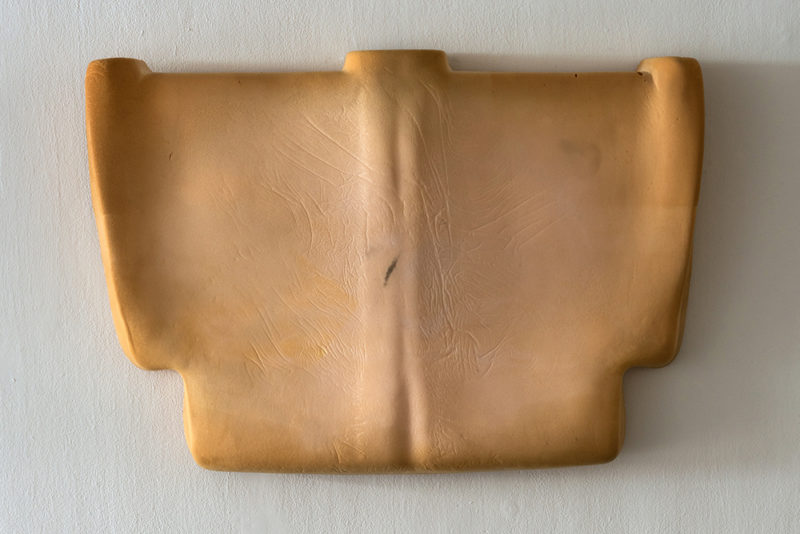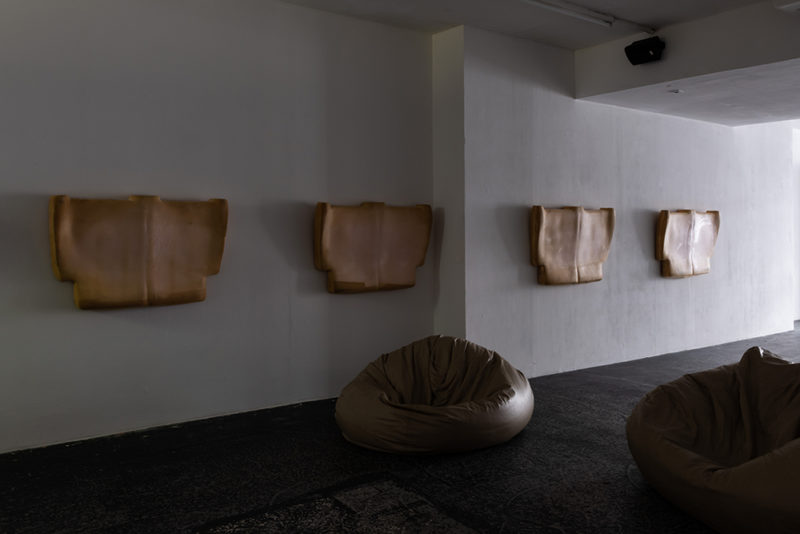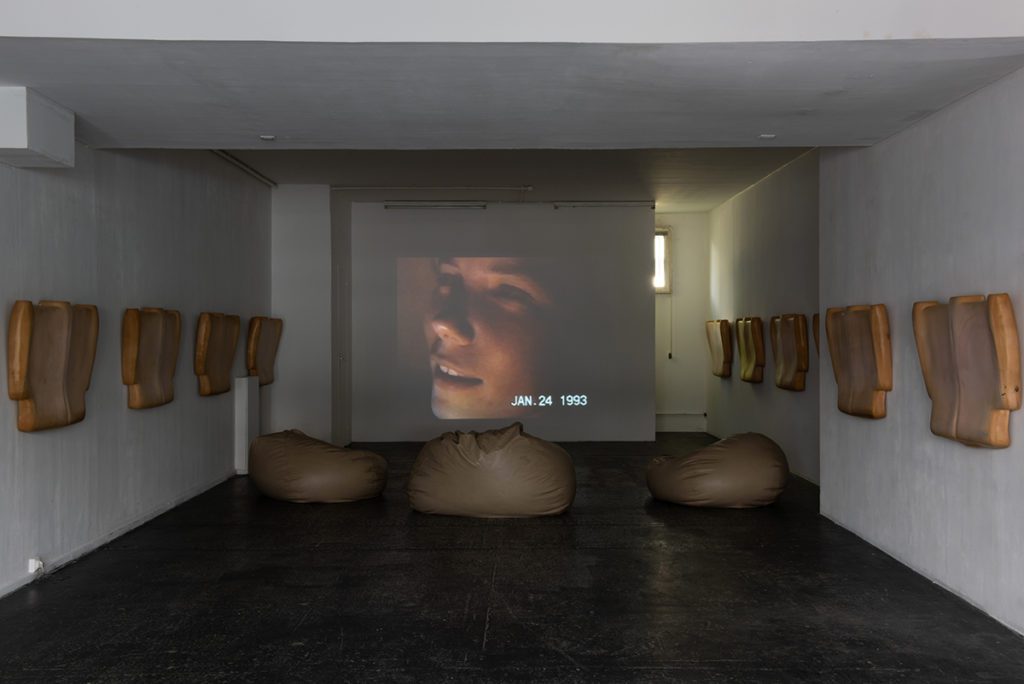Lutz Bacher at Treize, Paris
11 November 2022By Alex Turgeon

The martyrdom of Saint Bartholomew, one of the twelve apostles of Jesus, is said to have been the result of being flayed alive for his acts of Christianity by the Armenian King Astyages.1 The saint is often depicted in votive images carrying his flayed skin about him like a cloak, his anatomical musculature exposed as if it were truly rid of all worldly possessions from his selfless act of piety. One of the most iconic representations of Saint Bartholomew is his inclusion in Michelangelo’s The Last Judgement (1535-1541), which was part of the artist’s commissions for the Sistine Chapel. There, Bartholomew is presented under the right foot of Jesus, carrying his representative cloak of flesh in-hand. The face of this draped skin is often considered a self-portrait of the artist Michelangelo himself, rendered in the hollow folds of its mask-like face—absent of a body.
“I admire this person so much my knees bleed,” is heard from the recorded conversation between artist Lutz Bacher and an interviewee in Do You Love Me? (1994), a 12-hour video composed of back to back interrogations of friends, family and colleagues reflecting on Bacher herself, who conducted the interview off camera, her voice the only resonant depiction of her presence. The video is the central focus to Bacher’s posthumous exhibition Do You Love Me? which was on view at Treize, in Paris, France, this past summer. Through a series of open interview questions, the artist called on her subjects to describe what they really thought of her, within the intimacy of a one-on-one conversation. As the interviewees articulate their impressions of Bacher, their interactions and relations to the artist emerge through the calm and collected musings of a structured conversation, one that stretches into a physical depiction of the mind and body of the artist. Here, a kind of self-portrait-inferred-to-by-another-body is formed, by the sheer length of the video, into the scale of an epic.
The interior of Treize was a welcome respite from one of the hottest days in Paris on record. The exhibition space’s dim, ground floor location offered a moment of solace for my own melting flesh after a day of navigating the Parisian bake of midsummer. Amorphous bean bag chairs, evoking further kinds of bodies, allowed a cooling proximity to the gallery’s floor. I was encouraged to allow my own body to rest into their unstructured shape, my weight sinking me closer to the concrete, while my mind became awash in the banal, yet captivating, conversations recorded in Do You Love Me? Mounted on the remaining gallery walls, the sculptural work Untitled (2017), a series of fourteen almost-identical dense foam objects, turned the former storefront into an uncanny nave-like2 exhibition space, complete with its series of final judgements playing out before me.

Untitled was produced in the conceptual tradition of the found, or the better known, “pre-owned” object. Initially abstract, the series begins to suggest an almost figurative quality. Tinted in a macabre tone of Caucasian flesh, the sculptures induce a nude armature of a muscular back. Without their corresponding limbs, they seem to be the remnants of bodies having been drawn and quartered. Upon closer inspection, their mother mold could be the back seats of a car stripped of its upholstery, revealing the internal structure of a cushion scarred with histories of backseat conquests. Flayed of their skins, the sculptures repeat ad nauseum, making up a kind of congregation turned and lending away from their central subject. Their position evokes a reverence for negating any definitive meaning, and any interpretation beads off their smooth surfaces like quicksilver.
To be on one’s knees is an exquisite double-entendre: a position of reverence and submission while equally a form of flagellation in relation to the body as a record of experience. A disciple, or a fan, is often on their knees in awe of the presence of the divine. A pose of devotion, and the devotionally erotic, is to make the body physically and psychologically bend to power—the kind of power Bacher would often flirt with in her over fourty-year career. Here, “the body keeps the score” as Bessel van der Kolk infamously articulates in his New York Times best-selling book of the same name.3 Where van der Kolk reflects on the cause-and-effect of a body rooted in the trauma of the past, Do You Love Me? inversely performs a self-imposed raw psychoanalysis of the present—a peer-on-peer review in unedited, “real” time. “What do you think I want?” Bacher asks off camera to a friend sitting in a café. She is smoking a cigarette, lending to the work’s 90s nostalgia for cities like Paris or New York as former havens for cliquey groups of irreverent creatives, now post-capitalist shells of their former selves. “You want status…” her friend replies, shyly through the background atmosphere of the lunch rush, “I don’t think you’re out to change the world.”

As a portrait, Do You Love Me? meanders through the network Bacher had created with her cult of personality. Often described as being an “artist’s artist,” her work skirts distinction, slips between definitions and can “disperse like smoke.”4 Allusive since the start while avoiding any revealing statements about her work, Bacher has always side-stepped having to confine to a particular style, medium or identity, with even some of her closest friends never truly knowing her. Even after her sudden death in 2019, we as viewers are left to create the image of the artist from what remains, like a skin that has been shed in the wake of a presence. The conversations in Do You Love Me? are captivating because of the access Bacher seemingly provides into persona, but it’s the proximity to really knowing that entices the potential to bring us into her exclusive fold. Yet, we are led to infer on the image of the artist only through the space she leaves behind, her affect on those in the world she creates for us, as she depicts it to us. While Do You Love Me? might appear as a representation of self-exposure, it’s not: “The artist’s body is absent, but really present in its absence, it’s a glaring hole.”5 She is the ghost in a shell that seemingly slips through the fingers, continuing to perform her allusive identity even in these supposed acts of sincere transparency. In death, Bacher continues to leave us guessing who is really being depicted: is it really her? Or is it our anxieties for our own corporeal limits? She asks, do you love me? in the space which her mythical reputation has left behind. Now absent of a physical body, the artist’s portrait instead becomes a costume elongated into a representation of a life and work, for us to now drape ourselves in, complete with warts and all.
- Britannica, The Editors of Encyclopaedia. “Saint Bartholomew”. Encyclopedia Britannica, 3 Oct. 2016, https://www.britannica.com/biography/Saint-Bartholomew. Accessed 15 August 2022.
- A nave is the central part of a church building, intended to accommodate most of the congregation. In traditional Western churches it is rectangular, separated from the chancel by a step or rail, and from adjacent aisles by pillars.
- Bessel van der Kolk, The Body Keeps The Score: Brain, Mind, and Body in the Healing of Trauma, 2014. (New York: Penguin Books).
- Martin Herbert, Tell Them I Said No, 2016. (London: Sternberg Press), 73-74.
- Liz Kotz and Annette Schindler, Where Is Your Rupture?, 1998. (New York: The Swiss Institute), unpaginated.
Do You Love Me? ran from May 25 – June 25, 2022 at Treize in Paris, France and was curated by Julien Laugier.
Feature Image: Installation view of Do You Love Me? by Lutz Bacher at Treize, Paris. Courtesy of The Estate of Lutz Bacher & Galerie Buchholz. Photo by Yasmina Gonin.



